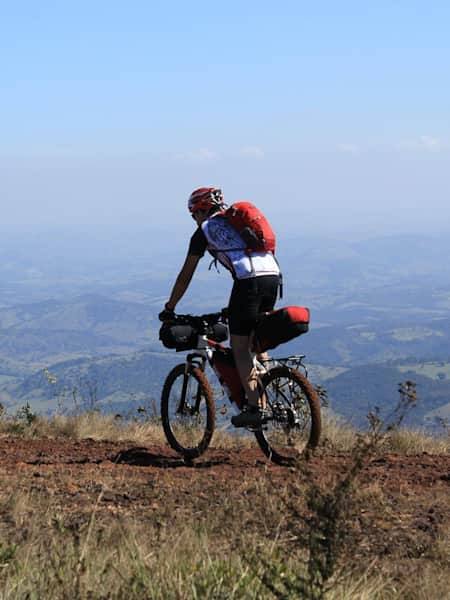Bike
The freedom of bikepacking your way through the countryside can be a complete get-away-from-it-all joy, but one surefire way of dropping a fly in that happy ointment is to overload yourself with unnecessary or unsuitable kit.
Here are a few of our hints and tips to keep the wheels turning and a smile on your face.
1. Swap a bulky tent for a bivvy bag
You can’t beat falling asleep under the stars and waking up to the sunrise from a hilltop, and using a bivvy bag cuts down on weight and bulk considerably. The addition of a lightweight tarp such as the Rab Siltarp to pitch over your head will keep the rain off as you. The only time we wouldn’t want bivvy bag is when dealing with the Scottish midge – then you need a tent to escape the critters!
2. Swap a foam sleeping mat for an inflatable one
Traditional foam sleeping mats are bulky and pretty uncomfortable affairs, but these days there is a viable alternative. Inflatable mats such as the Thermarest X-Lite pack down to the size of a beer can, weigh very little and – with a bit of pressure tweaking – are supremely comfortable.
3. Get a lightweight gas stove
If you are only going for a quick overnight escape you may not need a stove and pots at all. Then again, there is nothing better than going to bed after a hot meal or waking up to a good coffee to take in the spectacular view. Choose either a super-light gas stove like the Alpkit Kraku and 100g gas cartridge or a simple meths stove like the White Box which weighs next to nothing and burns in blissful silence.
4. Let your bike take the weight, not your back
You’ll need something to pack and carry this gear in, and luckily the range of bikepacking bags is ever expanding. Alpkit do a made to measure service for your bike frame, but others such as Ortlieb, Specialized and Blackburn do off-the-shelf options that should fit most bikes.
Get a large seat pack, a 15-20 litre drybag for the bars and any frame bags you can add into the middle to carry small bits. It all adds up, and making the effort to keep load off your back will help to make long days in the saddle more comfortable.
5. Only bring the necessary riding gear
Along with some spare shorts and thermals for replacing your riding kit on day two or three, make sure that you take a layer of clothing to wear in bed at night. Always keep this dry, never be tempted to use it through the day and no matter how wet and miserable you get, you always have that dry bed to look forward to. Make sure it is all snugly wrapped up in the dry bag of course.
6. Invest in an insulated jacket
An indispensable piece of kit is the humble Primaloft jacket such as the Sweet Protection Nutshell. When the weather cools down at night you can’t beat having one to pull on, and it's comfortable enough to keep on in the sleeping bag if you need extra insulation.
Down jackets may pack smaller and lighter, but get them damp and they are pretty much useless whereas the Primaloft keeps insulating. Remember to stow in a dry bag!
7. Any mountain bike will do
The last (and probably the most important) thing you'll need is a mountain bike. For the true off-road bikepacking experience many opt for the fat bike. With no suspension forks to worry about, fat tyres that skim over sand, bogs and soft ground and a pretty indestructible build they can be relied on when pushing into the wilderness.
That said, the best bike for the trip is the one you have in your garage – just saddle up and pedal into the sunset without getting caught up in the details.
8. Pack some essential tools
Don't forget to pack a few essential tools and spares in your saddle bag just in case something goes wrong. A multi-tool and a puncture kit are good to cover the basics but if you have space you might want to add spare tubes and a tyre pump. Two common problems are bent derailleur hangers and broken chains – easily fixed with your multi-tool if you keep a spare of each.
9. Leave behind the craziness of everyday life
Go light on social media. Smart phones are great for weather forecasts and snapping photos, but turn the social media and emails off – immerse yourself in the wilderness and leave the rest of the world behind even if only for a few days.




